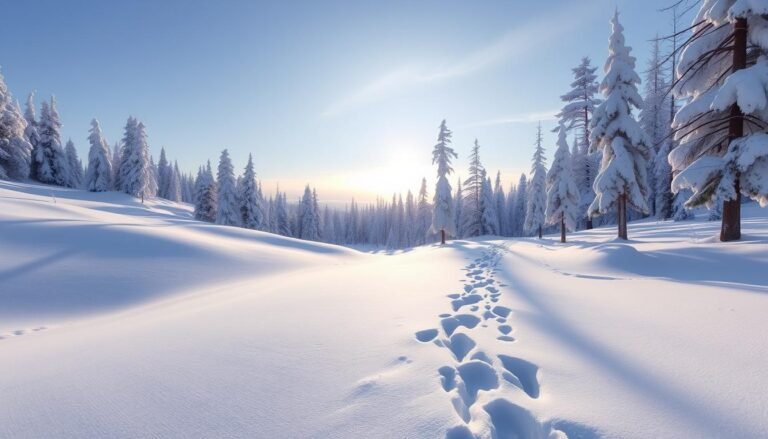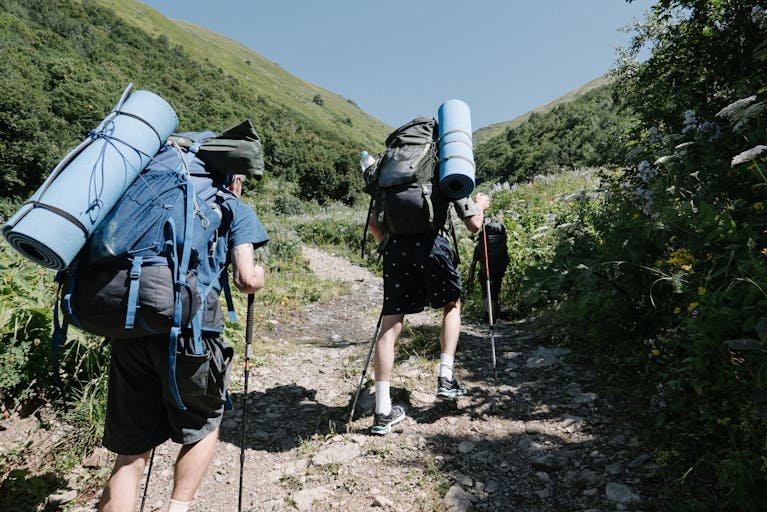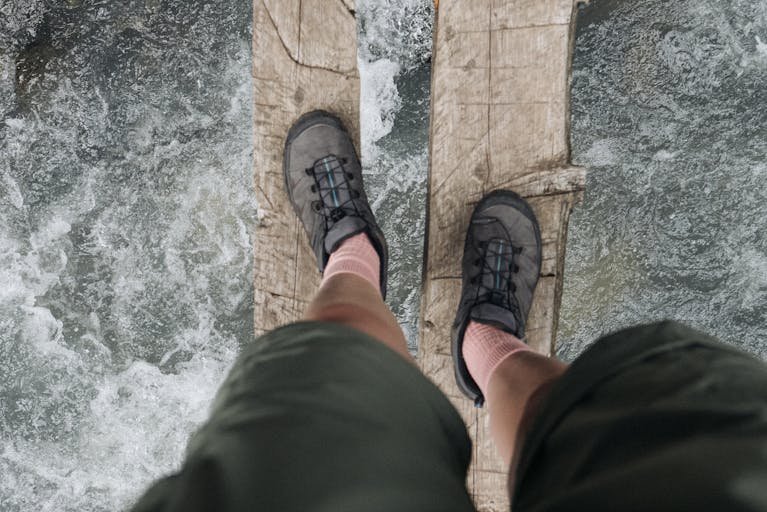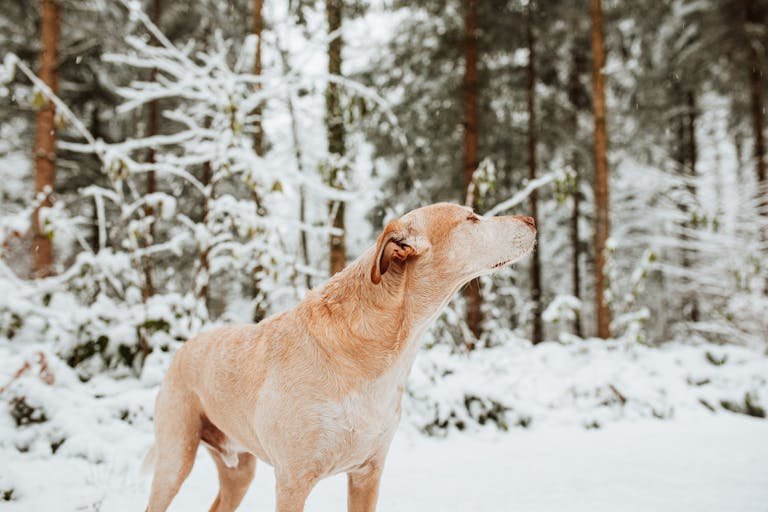Imagine walking on a snow-covered trail, surrounded by a winter wonderland. The air is crisp and invigorating. For outdoor lovers, winter hiking is a unique challenge. Yet, 4,000 people in the U.S. are rescued from the backcountry each year, mostly in winter.
Preparation and knowledge are key to safe winter hikes. This guide will give you the tips and techniques you need. You’ll learn about winter trekking basics, gear selection, and navigation. Get ready for your next icy adventure with confidence.

Key Takeaways
- Understand the unique challenges of winter hiking compared to summer trekking
- Learn how to select the right gear and clothing for cold-weather adventures
- Develop essential navigation skills for snow-covered trails
- Prioritize safety and emergency preparedness when venturing out in the winter
- Adopt sustainable and responsible winter hiking practices
Understanding Winter Hiking Fundamentals
Starting a winter hike means knowing the special challenges of snow trails. Winter changes the landscape, making hiking different from summer.
Differences Between Summer and Winter Trails
Winter trails are covered in snow, hiding landmarks and changing the path. Snow hides dangers like rocks and uneven ground. Cold weather and changing weather also make winter hiking harder.
Physical Demands of Cold Weather Trekking
Winter hiking is more tiring because your body fights to stay warm. You might feel more tired, strained, and at risk of cold injuries. Knowing these challenges helps keep you safe and happy.
Weather Pattern Assessment
Watching the weather is key for safe winter hiking. Quick changes in weather can make trails slippery and unsafe. Always check the forecast and be ready to adjust your plans.
“The winter wilderness is a realm of its own, where the elements command respect and preparation is the key to a successful and safe adventure.”
Essential Winter Hiking Gear and Equipment
When you go on a winter hike, the right gear is key for safety and comfort. Good snow hiking gear and winter safety items keep you warm and ready for cold weather.
A strong, waterproof, and breathable jacket is vital. Look for ones with insulation like down or synthetic fill. This keeps you warm without being too heavy. Also, get insulated and waterproof pants to keep your legs dry.
Don’t forget to layer your clothes. Start with moisture-wicking base layers, then insulating mid-layers, and finish with a weatherproof outer shell. This lets you adjust your warmth as needed.
Other must-haves include:
- Warm, insulated gloves or mittens
- A balaclava or neck gaiter to protect your face and neck
- High-quality, insulated winter boots with good traction
- Trekking poles or snowshoes to assist with stability and navigation
- A reliable compass, map, and GPS device to aid in navigation
- A headlamp or flashlight for visibility in low-light conditions
- A first-aid kit and emergency blanket
- A sturdy, insulated water bottle or hydration system
- High-calorie, nutrient-dense snacks to fuel your hike
Quality, durable gear is essential for safe and comfortable winter hikes. With the right snow hiking gear and winter safety items, you’re ready to enjoy the winter trails.
| Essential Winter Hiking Gear | Importance |
|---|---|
| Waterproof and Insulated Jacket | Provides core warmth and protection from wind and precipitation |
| Insulated Pants | Shields legs from cold and moisture, preventing heat loss |
| Warm Base Layers | Wicks away moisture to keep skin dry and regulate body temperature |
| Insulated Gloves or Mittens | Maintains dexterity and protects hands from the cold |
| Winter Hiking Boots | Provides traction and insulation for your feet in snowy conditions |
| Navigation Tools | Ensures you can find your way and stay on the trail in poor visibility |
| Emergency Gear | Helps you stay safe and prepared for unexpected situations |
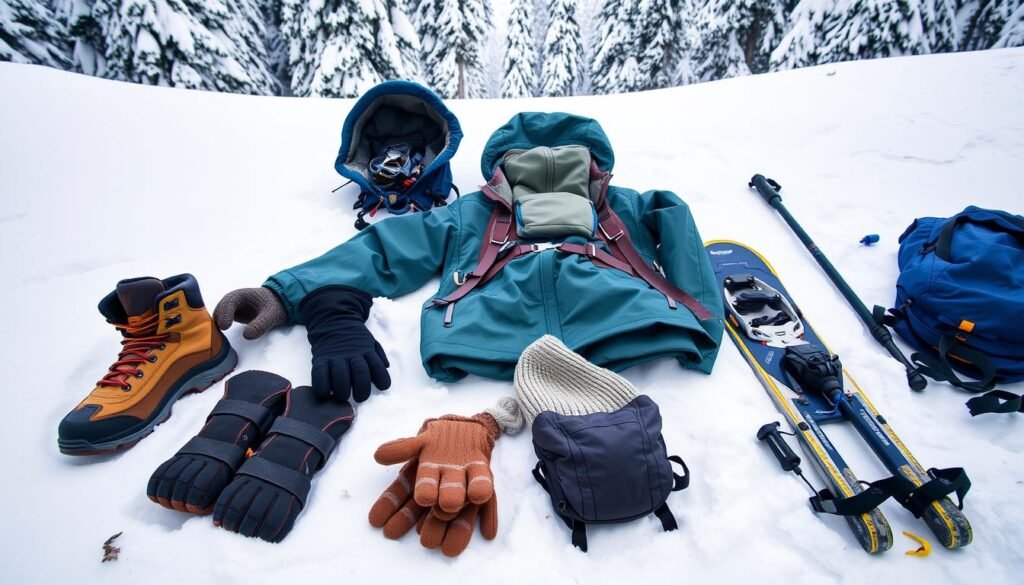
“The right gear can make all the difference between an enjoyable winter hike and a miserable experience.”
Proper Layering Techniques for Cold Weather
When it gets cold and snowy, layering is key for hikers. Learning how to layer right can make your hike warm and fun. Or, it can leave you cold and miserable. Let’s explore the best ways to layer for your winter adventures.
Base Layer Selection
The base layer is important for keeping you warm. Pick fabrics that pull moisture away from your skin, like synthetic or merino wool. Cotton is bad because it holds moisture, making you cold and wet. Go for lightweight, snug base layers that fit well.
Insulating Layer Options
The insulating layer keeps you warm by trapping heat. Fleece, down, or synthetic puffy jackets are great because they’re warm without being too heavy. Think about how active you’ll be and the weather when picking your insulating layer.
Outer Shell Requirements
The outer shell protects you from the weather. Choose a waterproof and breathable jacket and pants to keep out wind, rain, and snow. It should fit well enough to move easily but not be too loose.
Learning to layer well keeps you warm on winter hikes. Adjust your layers as needed to stay comfortable. This way, you can enjoy the winter wilderness without getting cold.
| Layer | Material | Purpose |
|---|---|---|
| Base Layer | Synthetic or Merino Wool | Moisture wicking and temperature regulation |
| Insulating Layer | Fleece, Down, or Synthetic Puffy | Trapping heat and providing warmth |
| Outer Shell | Waterproof and Breathable | Protection from wind, rain, and snow |
“Proper layering is the key to staying comfortable and dry during your winter hikes. It’s all about finding the right balance between insulation and breathability.”
Footwear and Traction Solutions
Winter hiking requires the right footwear and traction solutions for comfort and safety. Snowy trails demand special gear to keep your feet warm, dry, and stable.
Choosing the Proper Winter Hiking Boots
Boots should be well-insulated, waterproof, and have sturdy soles with deep lugs. Leather or synthetic materials protect against the elements. A breathable lining helps keep your feet at a comfortable temperature.
Make sure the boots fit well, allowing for thick socks and custom insoles. This ensures a snug, supportive fit for your unique foot shape.
Traction Devices for Snow and Ice
For slippery terrain, add traction devices to your snow hiking gear. Microspikes offer great grip on snow and ice. For steeper, icier slopes, crampons with longer spikes are better.
Snowshoes are great for deep, soft snow. They spread your weight and prevent sinking, making winter trails easier to navigate.
| Traction Device | Best For | Terrain |
|---|---|---|
| Microspikes | Packed Snow, Ice | Moderate Slopes, Trails |
| Crampons | Steep, Icy Slopes | Glaciers, Technical Routes |
| Snowshoes | Deep, Soft Snow | Flat to Moderate Terrain |
Choosing the right snow hiking gear for your feet ensures a safe, comfortable winter hike. It doesn’t matter what the trail throws your way.
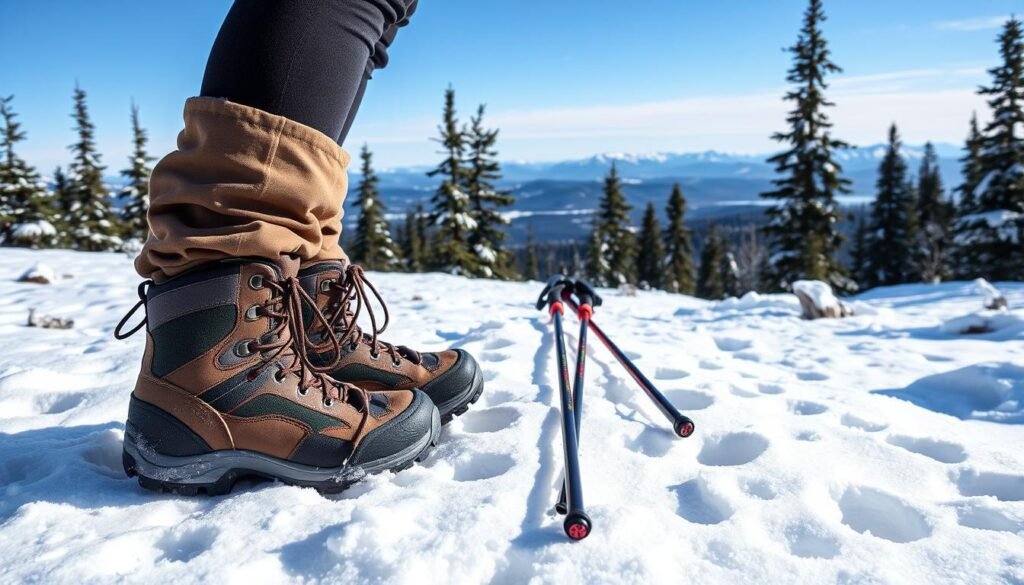
Navigation Skills and Tools for Snow-Covered Trails
Navigating winter trails is a unique challenge. But with the right skills and tools, you can explore snowy landscapes with confidence. Learning GPS and map reading is key to staying on track. Also, knowing how to mark trails and read weather signs helps you prepare for changes.
GPS and Traditional Map Reading
GPS devices are now essential for winter hikers. They offer precise location data and route tracking. But, it’s also important to know traditional map and compass skills. This way, you can navigate safely even when technology fails.
Trail Marking in Snow
Visible markers are crucial on snow-covered trails. Learn to leave clear trail markers like flagging tape or cairns. These signs help you find your way, even in whiteout conditions.
Understanding Weather Signs
Knowing weather patterns is vital for winter trail navigation. Watch for cloud formations, wind direction, and temperature changes. This helps you predict storms or blizzards. Always check local weather forecasts and be ready to change your plans if needed.
| Navigation Tool | Key Benefits |
|---|---|
| GPS Device | Precise location tracking, route guidance, and data storage |
| Compass and Topographic Map | Traditional navigation skills, useful when technology fails |
| Trail Markers | Visual cues to follow the path, especially in snowy conditions |
| Weather Observation | Anticipate changing conditions and plan accordingly |
Mastering winter trail navigation skills and using the right tools is crucial. By combining GPS, map reading, trail marking, and weather awareness, you’ll navigate snowy landscapes confidently.
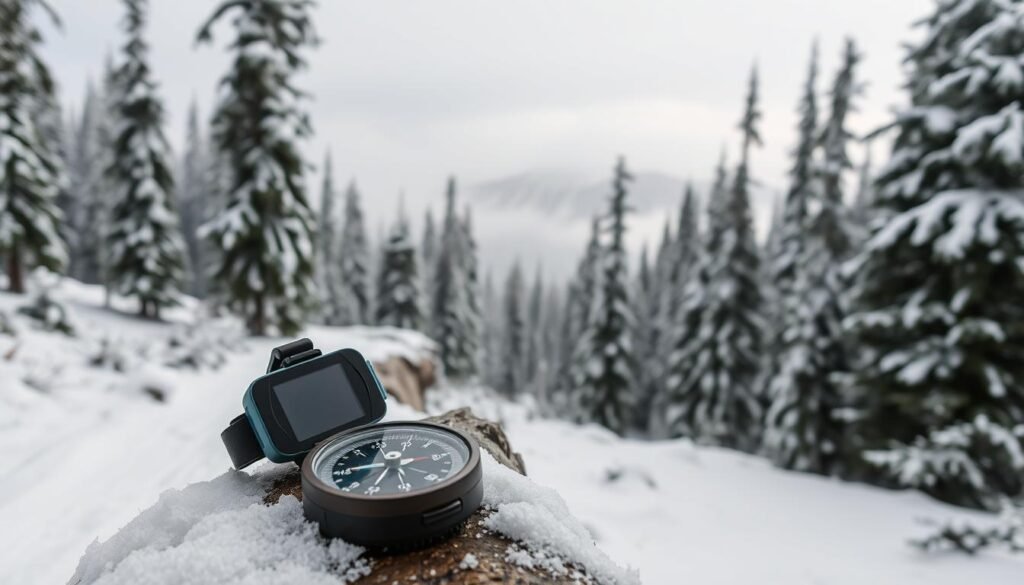
Safety Precautions and Emergency Preparedness
When you head out into the winter wilderness, safety is key. You need to protect yourself from frostbite and hypothermia. Having the right gear and planning can ensure a fun and safe winter hike.
Frostbite Prevention Tips
Exposed skin is at risk for frostbite. So, it’s important to cover up. Wear insulated gloves, a warm hat, and a neck gaiter or balaclava. Watch out for your nose, ears, and cheeks, and act fast if you see signs of frostbite.
Essential Winter Safety Gear
- Insulated, waterproof boots with good traction
- Warm, layered clothing that wicks moisture
- Emergency blanket or bivy sack
- Portable heat source, such as a portable stove or hand warmers
- First-aid kit and emergency supplies
Avalanche Awareness and Preparedness
In snowy areas, knowing about avalanche risks is vital. Check forecasts, learn to spot danger zones, and carry safety gear like a beacon, shovel, and probe. If caught in an avalanche, know how to stay safe and signal for help.
| Emergency Preparedness Checklist | Essential Items |
|---|---|
| Winter Hiking Safety Essentials | Waterproof matches or lighter Flashlight or headlamp Emergency whistle Signaling mirror Space blanket |
| First-Aid Kit Components | Bandages and gauze pads Antiseptic wipes Pain relievers Instant cold pack Emergency medications |
By focusing on frostbite prevention tips and having the right winter safety essentials, you’re ready for the cold wilderness. Enjoy a safe and rewarding winter hike.
Winter Trail Etiquette and Environmental Impact
As avid winter hikers, we must follow responsible and sustainable practices. We should respect the winter ecosystems to keep our adventures green. This way, we can enjoy the trails without harming the environment or its creatures.
Leave No Trace Principles
Winter hiking means following the Leave No Trace principles more closely. We should pack out all trash, stay on trails, and not damage snow. It’s also key to be careful with our steps to keep trails beautiful for others.
Protecting Winter Wildlife
Winter is tough for wildlife, as they need to save energy and find food. As winter hikers, we must watch out for animals and not disturb them. Keeping a distance, respecting their homes, and not making new trails helps protect them.
Trail Sharing Guidelines
Winter trails are used by many, like snowshoers, skiers, and bikers. To keep everyone safe and happy, we need to follow trail rules. This means giving way to those going uphill, talking to others, and thinking about how our activities affect the trails.
By being responsible winter hikers, we can enjoy the snow while protecting it. Our actions help keep these beautiful places safe for future explorers. Together, we can preserve the winter wonderlands for all to enjoy.
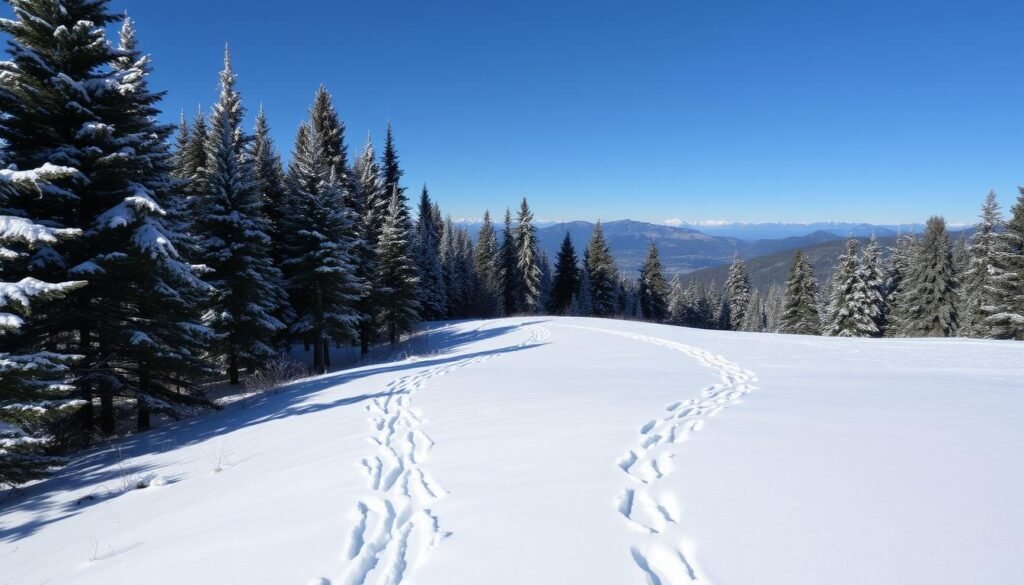
Nutrition and Hydration Strategies
When you go winter hiking, it’s key to eat right and drink enough water. The cold and hard work can use up your energy fast. If you don’t stay hydrated, you might get dehydrated. The right food and water can keep you safe and happy on your hike.
Preventing Water from Freezing
Keeping your water from freezing is a big challenge in the cold. Here are some tips to help:
- Use neoprene sleeves or a scarf to keep your water bottles warm.
- Carry a thermos with hot water to thaw frozen bottles or refill your pack.
- Keep your water bottles or pack inside your jacket to use your body heat.
Fuel-Rich Snacks for Cold-Weather Hiking
In winter, your body needs more calories to stay warm. Choose snacks that are full of energy and nutrients:
- Nut butters and energy bars
- Dried fruit and trail mix
- Granola and oatmeal packets
- Chocolate-covered espresso beans
Eat these snacks often to keep your energy up and avoid getting tired.
| Nutrient | Importance for Winter Hiking | Food Sources |
|---|---|---|
| Carbohydrates | Provide quick-burning fuel for muscles | Whole grains, fruits, vegetables |
| Protein | Supports muscle recovery and growth | Lean meats, beans, nuts, eggs |
| Healthy Fats | Promote sustained energy release | Avocados, olive oil, nuts, seeds |
Focus on hydration in freezing temperatures and eating snacks full of nutrients. This will keep your body ready for winter hiking.
“Staying properly nourished and hydrated is the foundation for a successful and safe winter hike. Don’t let the cold catch you unprepared.”
Advanced Winter Hiking Techniques
As winter hiking season goes on, adventurers look to learn more. They might want to try snowshoeing or tackle river crossings. These skills make winter hikes more exciting and open up new places to explore.
Snowshoeing Basics
Snowshoeing lets you walk on snow easily. To do it well, keep a steady pace and move your weight from one foot to the other. Use your poles to help with balance and moving forward.
Learning to turn and climb slopes smoothly is key. It makes snowshoeing more enjoyable and efficient.
Ice Axe Usage
For those tackling tough terrain, an ice axe is essential. It takes practice to use it right. Learn to stop yourself, slide down slopes, and move safely on ice.
Getting good at these skills can mean the difference between a safe climb and a risky one.
River and Stream Crossings
Winter river crossings are both tough and rewarding. First, check if the ice is solid and find safe spots to start and end. Use your ice axe and poles for support.
It’s smart to link arms with your friends for extra safety. Always be ready to turn back if it’s too risky.
Learning these advanced techniques helps you conquer the toughest winter landscapes. Always put safety first, practice, and enjoy the adventure.
| Technique | Description | Benefits |
|---|---|---|
| Snowshoeing | Maintaining a steady, natural stride, shifting weight, and using poles for balance and propulsion. | Allows for efficient traversal of snow-covered terrain, providing access to remote winter landscapes. |
| Ice Axe Usage | Mastering self-arrest, glissades, and navigating icy slopes. | Enhances safety and control in technical winter hiking conditions, enabling access to more challenging terrain. |
| River and Stream Crossings | Assessing crossing conditions, using tools for stability, and forming a human chain for added safety. | Expands the range of winter hiking routes and allows for the exploration of previously inaccessible areas. |
Conclusion
As you start your winter hiking, remember the key tips from this article. Getting ready for cold weather is crucial. It helps you stay safe and enjoy the winter trails.
Whether you’re experienced or new to winter hiking, staying alert is important. Knowing the weather, how to navigate, and safety tips can save you. By following cold weather trekking best practices, you can enjoy the beauty and challenges of winter.
Keep exploring winter trails and enjoy the season’s unique rewards. The quiet of snow and the feeling of overcoming challenges are special. With the right gear and knowledge, your winter hiking adventures will be unforgettable and inspiring.
FAQ
What are the key differences between summer and winter hiking trails?
Winter trails have deeper snow and ice, making them harder to navigate. You’ll also need to carry more gear, which adds weight. This makes winter hiking more challenging physically.
How can I properly prepare for the physical demands of cold weather trekking?
To get ready for winter hiking, start exercising regularly. Focus on workouts that mimic the trail’s terrain and movements. This includes hiking with a heavy backpack and snowshoeing.
What are the essential pieces of gear I need for a successful winter hike?
For winter hiking, you’ll need warm, waterproof clothes and sturdy boots. Don’t forget traction aids, a GPS, map, compass, first-aid kit, and emergency supplies like a fire starter and extra food.
How should I layer my clothing for optimum warmth and comfort in cold weather?
Layering is crucial for staying warm. Start with a moisture-wicking base layer. Add a fleece or down jacket for insulation. Finish with a waterproof outer shell. Adjust your layers as needed.
What are the best types of footwear and traction devices for winter hiking?
Choose boots that are well-insulated and waterproof. They should have a sturdy sole and room for thick socks. Microspikes or crampons are great for icy or snowy trails, helping prevent slips.
How can I effectively navigate winter trails and read weather signs?
Use GPS, maps, and compasses to navigate winter trails. Learn to read weather signs to anticipate changes. This helps you make smart decisions on the trail.
What are the most important safety precautions to consider for winter hiking?
Preventing frostbite and hypothermia is key. Be aware of avalanches and have emergency gear ready. Always check the weather and pack extra supplies.
How can I ensure I stay properly hydrated and fueled during a winter hike?
Stay hydrated and fueled in cold weather. Use insulated containers for water and pack high-energy snacks. This helps keep your energy up.
What are some advanced winter hiking techniques I should learn?
Learn advanced skills like snowshoeing and using an ice axe. These skills help you tackle tougher winter terrain. They’re essential for more challenging hikes.


